Exchange Currency
Egyptian pound
The Egyptian Pound or Gineih is the currency of Egypt and it is divided into 100 Qirsh or 1000 Milliemes. The ISO 4217 code of Egyptian Pound is EGP. Locally, the abbreviation LE or L.E., which stands for „livre égyptienne” (French for Egyptian pound) is frequently used. E£ and £E are rarely used. The name Gineih was derived from the Guinea coin which had the almost the same value of 100 Qirush at the end of the 19th century.
Because Egyptian mints were insufficient to satisfy the requirements of large transactions as well as foreign trade, and because of the use of foreign coins for this purpose, legal exchange rates were fixed by force of law for important foreign currencies which became acceptable in the settlement of internal transactions. Fluctuations in the value of silver in addition to the adoption of the gold standard by most of the countries trading with Egypt, particularly the United Kingdom, led to the application of the gold standard, on a de facto basis, after almost thirty years of a bimetallic standard.
Following the financial crisis resulting from the accumulation of Egypt’s external debt, the Monetary Reform Law was issued in 1885. By virtue of this Law, the gold standard became the basis for the Egyptian monetary system, and the country had a unified currency, the Egyptian gold pound. Thus, the bimetallic standard was officially abandoned.
Owing to the insufficiency of minted new gold pounds, it was permitted to use some foreign gold coins, particularly the Sterling pound, at fixed legal rates. While the Egyptian gold pound was still deemed a legal tender, the Sterling gold pound, which was valued at more than its gold content compared to other foreign gold coins, remained the main medium of exchange, and the monetary system was no longer based on the ordinary gold standard but on the Sterling gold standard.
Gold coins remained the medium of exchange until 1898 when the National Bank of Egypt was established and was granted, by the government, the privilege to issue Egyptian banknotes, payable in gold for a period of 50 years. The National Bank of Egypt started issuing banknotes for the first time on the 3rd of April 1899.
Consequently, the currency circulated in Egypt consisted of gold Sterling pounds and Egyptian banknotes convertible into gold. This situation continued up to 2/8/1914 when a special Decree was issued making Egyptian banknotes a legal tender and suspending their convertibility into gold. Thus, the Egyptian pound banknote became the basic currency unit, and the base of the Egyptian monetary system was changed to fiduciary paper money standard. Accordingly, gold coins were no longer used in circulation, with the result that the volume of banknote issue increased from LE 11.6 million at the end of 1915 to LE 3557.0 million at the end of 1980, and further to LE 38320.0 million at the end of 1999. In 1930, for the first time in the history of Egyptian banknotes, a watermark was used in issued banknotes. This was followed, towards the end of 1968, by using a metallic thread (in banknotes issued by the Central Bank of Egypt) as a guarantee against counterfeit instead of dependence on complexity of colors .Other features against counterfeit were found in the detailed specifications of each currency. Holograms are currently added to large denomination banknotes.
On the 19th of July 1960, Law No.250 was promulgated. It was amended in November of the same year by Law No.277 with respect to the Central Bank of Egypt and the National Bank of Egypt. The Law provided for the establishment of the Central Bank of Egypt conferring upon the CBE the right of issuing Egyptian banknotes. Several changes were introduced with respect to the watermark, the designs shown on the banknotes and the colors.
The efforts of the Central Bank of Egypt in the field of banknote issue were culminated in the establishment of a printing plant for banknotes instead of printing them abroad. The plant’s production of banknotes in different denominations started in December 1968. The Bank also served some Arab central banks in printing their banknotes.
In view of the increasing need of banknotes to facilitate transactions resulting from the growth of economic activity, following the introduction of the open-door policy, the Central Bank of Egypt issued banknotes of large denominations (20,50,100). It launched the denomination of 20 pounds in May 1977 and 100 pounds in May 1979 and 50 pounds in March 1993.
The period 1990-2004 witnessed large and continuous increases in banknote issue compared with previous periods. The average rate of increase during that period stood at 11.7%.
Banknote issue cover is currently composed of gold and Egyptian treasury banknotes. The relative importance of such components as at end of June 2004 was as follows: 7.4% gold, and 92.6% treasury banknotes.
The proportional distribution of banknote issue by denomination as at end of June 2004 was as follows:
Copper 10 para coins were introduced in 1853, although the silver coin continued to be issued. Copper 10 para coins were again introduced in 1862, followed by copper 4 para and 21⁄2 piastre coins in 1863. Gold 25 piastre coins were introduced in 1867.
In 1885, a new coinage was introduced consisting of bronze 1⁄4 , 1⁄2 , 1, 2 and 5 millieme, silver 1, 2, 5, 10 and 20 piastre coins. The gold coinage practically ceased, with only small numbers of 5 and 10 piastre coins issued.
In 1916 and 1917, a new base metal coinage was introduced consisting of bronze 1⁄2 millieme and holed, cupro-nickel 1, 2, 5 and 10 millieme coins. Silver 2, 5, 10 and 20 piastre coins continued to be issued, and a gold 1 pound coin was reintroduced. Between 1922 and 1923, the gold coinage was extended to include 20 and 50 piastre and 1 and 5 pound coins. In 1924, bronze replaced cupro-nickel in the 1 millieme coin and the holes were removed from the other cupro-nickel coins. In 1938, bronze 5 and 10 millieme coins were introduced, followed in 1944 by silver, hexagonal 2 piastre coins.
Between 1954 and 1956, a new coinage was introduced, consisting of aluminum-bronze 1, 5 and 10 millieme and silver 5, 10 and 20 piastre coins, with the size of the silver coinage significantly reduced. An aluminum-bronze 2 millieme coin was introduced in 1962. In 1967 the silver coinage was abandoned and cupro-nickel 5 and 10 piastre coins were introduced.
Aluminum replaced aluminum-bronze in the 1, 5 and 10 millieme coins in 1972, followed by brass in the 5 and 10 millieme coins in 1973. Aluminum-bronze 2 piastre and cupro-nickel 20 piastre coins were introduced in 1980, followed by aluminum-bronze 1 and 5 piastre coins in 1984. In 1992, brass 5 and 10 piastre coins were introduced, followed by holed, cupro-nickel 25 piastre coins in 1993. The size of 5 piastre coins was reduced in 2004, 10 and 25 piastre coins — in 2008.
On June 1, 2006, 50 piastre and 1 pound coins with date 2005 were introduced, with the equivalent banknotes to be scrapped later. The coins bear the faces of Cleopatra VII and Tutankhamun, and the 1 pound coin is bimetallic. The size of 50 piastre coins was reduced in 2007.
With the possible exception of the now-ubiquitous 1-pound coin, coins are encountered much less frequently than notes, even for the smallest amounts, but coins down to 5 piastres remain legal currency.
In 1961, the Central Bank of Egypt took over from the National Bank and issued banknotes in denominations of 25 and 50 Piasters, 1, 5 Pounds, 10 and 20 Pounds banknotes were introduced in 1976, followed by 100 gineih in 1978, 50 Pound in 1993 and 200 Egyptian Pounds in 2007.
All Egyptian banknotes are bilingual, with Arabic texts and Eastern Arabic numerals on the obverse and English and Hindu Arabic numerals on the reverse. Obverse designs tend to feature an Islamic building with reverse designs featuring Ancient Egyptian motifs (buildings, statues and inscriptions). During December 2006, it was mentioned in articles in Al Ahram and Al Akhbar newspapers that there were plans to introduce a 200 and 500 Pound banknotes. As of 2007, there are 200 Pound banknotes circulating in Egypt and subsequently 500 Pound banknotes will start circulating. As of the summer of 2009, banknotes of one pound and one half pound are being phased out, replaced by more extensive use of coins. Presumably quarter pound banknotes will be phased out as well.
Summary info
Summary information about Egyptian pound- ISO 4217 Code:
- EGP
- Currency sign:
- E£
- Country:
- Egypt
- Subunit:
- qirsh
- Coins:
- 5 piastres, 10 piastres, 20 piastres, 25 piastres, 50 piastres, 1 pound
- Banknotes:
- 0.25 Egyptian pounds, 0.50 Egyptian pounds, 1 Egyptian pounds, 5 Egyptian pounds, 10 Egyptian pounds, 20 Egyptian pounds, 50 Egyptian pounds, 100 Egyptian pounds, 200 Egyptian pounds
- Central bank:
- Central Bank of Egypt
History
Since the beginning of the circulation of silver and gold coins in Egypt and until 1834, no specified monetary unit existed to serve as a basis for the monetary system in Egypt. Only a few of the coins were minted locally. In 1834, a Decree was promulgated providing for issuing an Egyptian currency based on a bimetallic base. By virtue of this Decree the minting of coins in the form of gold and silver riyals was monopolized by the government. In 1836 the Egyptian pound was minted and put into circulation.Because Egyptian mints were insufficient to satisfy the requirements of large transactions as well as foreign trade, and because of the use of foreign coins for this purpose, legal exchange rates were fixed by force of law for important foreign currencies which became acceptable in the settlement of internal transactions. Fluctuations in the value of silver in addition to the adoption of the gold standard by most of the countries trading with Egypt, particularly the United Kingdom, led to the application of the gold standard, on a de facto basis, after almost thirty years of a bimetallic standard.
Following the financial crisis resulting from the accumulation of Egypt’s external debt, the Monetary Reform Law was issued in 1885. By virtue of this Law, the gold standard became the basis for the Egyptian monetary system, and the country had a unified currency, the Egyptian gold pound. Thus, the bimetallic standard was officially abandoned.
Owing to the insufficiency of minted new gold pounds, it was permitted to use some foreign gold coins, particularly the Sterling pound, at fixed legal rates. While the Egyptian gold pound was still deemed a legal tender, the Sterling gold pound, which was valued at more than its gold content compared to other foreign gold coins, remained the main medium of exchange, and the monetary system was no longer based on the ordinary gold standard but on the Sterling gold standard.
Gold coins remained the medium of exchange until 1898 when the National Bank of Egypt was established and was granted, by the government, the privilege to issue Egyptian banknotes, payable in gold for a period of 50 years. The National Bank of Egypt started issuing banknotes for the first time on the 3rd of April 1899.
Consequently, the currency circulated in Egypt consisted of gold Sterling pounds and Egyptian banknotes convertible into gold. This situation continued up to 2/8/1914 when a special Decree was issued making Egyptian banknotes a legal tender and suspending their convertibility into gold. Thus, the Egyptian pound banknote became the basic currency unit, and the base of the Egyptian monetary system was changed to fiduciary paper money standard. Accordingly, gold coins were no longer used in circulation, with the result that the volume of banknote issue increased from LE 11.6 million at the end of 1915 to LE 3557.0 million at the end of 1980, and further to LE 38320.0 million at the end of 1999. In 1930, for the first time in the history of Egyptian banknotes, a watermark was used in issued banknotes. This was followed, towards the end of 1968, by using a metallic thread (in banknotes issued by the Central Bank of Egypt) as a guarantee against counterfeit instead of dependence on complexity of colors .Other features against counterfeit were found in the detailed specifications of each currency. Holograms are currently added to large denomination banknotes.
On the 19th of July 1960, Law No.250 was promulgated. It was amended in November of the same year by Law No.277 with respect to the Central Bank of Egypt and the National Bank of Egypt. The Law provided for the establishment of the Central Bank of Egypt conferring upon the CBE the right of issuing Egyptian banknotes. Several changes were introduced with respect to the watermark, the designs shown on the banknotes and the colors.
The efforts of the Central Bank of Egypt in the field of banknote issue were culminated in the establishment of a printing plant for banknotes instead of printing them abroad. The plant’s production of banknotes in different denominations started in December 1968. The Bank also served some Arab central banks in printing their banknotes.
In view of the increasing need of banknotes to facilitate transactions resulting from the growth of economic activity, following the introduction of the open-door policy, the Central Bank of Egypt issued banknotes of large denominations (20,50,100). It launched the denomination of 20 pounds in May 1977 and 100 pounds in May 1979 and 50 pounds in March 1993.
The period 1990-2004 witnessed large and continuous increases in banknote issue compared with previous periods. The average rate of increase during that period stood at 11.7%.
Banknote issue cover is currently composed of gold and Egyptian treasury banknotes. The relative importance of such components as at end of June 2004 was as follows: 7.4% gold, and 92.6% treasury banknotes.
The proportional distribution of banknote issue by denomination as at end of June 2004 was as follows:
- 30.9% of one hundred pounds;
- 38.0% of fifty pounds;
- 18.4% of twenty pounds;
- 9.2% of ten pounds;
- 2.1% of five pounds;
- 0.9% of one pound;
- 0.3% of fifty piasters;
- 0.2% of twenty five piasters;
Coins
Between 1834 and 1836, copper 1 and 5 para, silver 10 and 20 para, 1, 5, 10 and 20 piastre, gold 5, 10 and 20 piastre and 1 pound coins were introduced, with gold 50 piastre coins following in 1839. (1 Para = 1⁄40 Piastre).Copper 10 para coins were introduced in 1853, although the silver coin continued to be issued. Copper 10 para coins were again introduced in 1862, followed by copper 4 para and 21⁄2 piastre coins in 1863. Gold 25 piastre coins were introduced in 1867.
In 1885, a new coinage was introduced consisting of bronze 1⁄4 , 1⁄2 , 1, 2 and 5 millieme, silver 1, 2, 5, 10 and 20 piastre coins. The gold coinage practically ceased, with only small numbers of 5 and 10 piastre coins issued.
In 1916 and 1917, a new base metal coinage was introduced consisting of bronze 1⁄2 millieme and holed, cupro-nickel 1, 2, 5 and 10 millieme coins. Silver 2, 5, 10 and 20 piastre coins continued to be issued, and a gold 1 pound coin was reintroduced. Between 1922 and 1923, the gold coinage was extended to include 20 and 50 piastre and 1 and 5 pound coins. In 1924, bronze replaced cupro-nickel in the 1 millieme coin and the holes were removed from the other cupro-nickel coins. In 1938, bronze 5 and 10 millieme coins were introduced, followed in 1944 by silver, hexagonal 2 piastre coins.
Between 1954 and 1956, a new coinage was introduced, consisting of aluminum-bronze 1, 5 and 10 millieme and silver 5, 10 and 20 piastre coins, with the size of the silver coinage significantly reduced. An aluminum-bronze 2 millieme coin was introduced in 1962. In 1967 the silver coinage was abandoned and cupro-nickel 5 and 10 piastre coins were introduced.
Aluminum replaced aluminum-bronze in the 1, 5 and 10 millieme coins in 1972, followed by brass in the 5 and 10 millieme coins in 1973. Aluminum-bronze 2 piastre and cupro-nickel 20 piastre coins were introduced in 1980, followed by aluminum-bronze 1 and 5 piastre coins in 1984. In 1992, brass 5 and 10 piastre coins were introduced, followed by holed, cupro-nickel 25 piastre coins in 1993. The size of 5 piastre coins was reduced in 2004, 10 and 25 piastre coins — in 2008.
On June 1, 2006, 50 piastre and 1 pound coins with date 2005 were introduced, with the equivalent banknotes to be scrapped later. The coins bear the faces of Cleopatra VII and Tutankhamun, and the 1 pound coin is bimetallic. The size of 50 piastre coins was reduced in 2007.
With the possible exception of the now-ubiquitous 1-pound coin, coins are encountered much less frequently than notes, even for the smallest amounts, but coins down to 5 piastres remain legal currency.
Banknotes
In 1899, the National Bank of Egypt introduced banknotes in denominations of 50 Piastres, 1 5, 10, 50 and 100 Egyptian Pounds were introduced. Between 1916 and 1917, 25 Piastres banknotes were added, together with government currency banknotes for 5 and 10 Piastres. Issued intermittently, the 5 and 10 Piastres are today produced by the Ministry of Finance.In 1961, the Central Bank of Egypt took over from the National Bank and issued banknotes in denominations of 25 and 50 Piasters, 1, 5 Pounds, 10 and 20 Pounds banknotes were introduced in 1976, followed by 100 gineih in 1978, 50 Pound in 1993 and 200 Egyptian Pounds in 2007.
All Egyptian banknotes are bilingual, with Arabic texts and Eastern Arabic numerals on the obverse and English and Hindu Arabic numerals on the reverse. Obverse designs tend to feature an Islamic building with reverse designs featuring Ancient Egyptian motifs (buildings, statues and inscriptions). During December 2006, it was mentioned in articles in Al Ahram and Al Akhbar newspapers that there were plans to introduce a 200 and 500 Pound banknotes. As of 2007, there are 200 Pound banknotes circulating in Egypt and subsequently 500 Pound banknotes will start circulating. As of the summer of 2009, banknotes of one pound and one half pound are being phased out, replaced by more extensive use of coins. Presumably quarter pound banknotes will be phased out as well.
EGP banknotes pictures gallery
| 0.25 Egyptian Pounds | |
|---|---|
| Banknote of 0.25 Egyptian Pounds has dimensions 130×70 mm and main colors are pastel blue, light slate gray, cool grey and platinum. The issue date of 25 Egyptian piastres banknote was 15 July 1996 and have a watermark with the statue of Tutankhamoun. | |
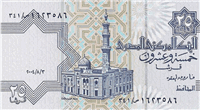 Obverse side of the 0.25 Egyptian Pounds is showing the Mosque of Al-Sayida Aisha. |
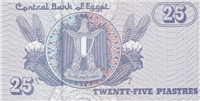 Reverse side of the 0.25 Egyptian Pounds is showing the Eagle of Salah El Din (the emblem of the Egypt). |
| 0.50 Egyptian Pounds | |
|---|---|
| Banknote of 0.50 Egyptian Pounds has dimensions 135×70 mm and main colors are almond, grullo, platinum and pearl. The issue date of 50 Egyptian piastres banknote was 15 July 1996 and have a watermark with the mask of Tutankhamoun. | |
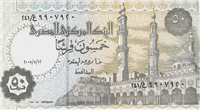 Obverse side of the 0.50 Egyptian Pounds is showing the Mosque of Al Azhar and its minarets with Islamic decoration. |
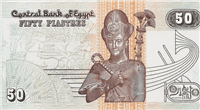 Reverse side of the 0.50 Egyptian Pounds is showing the statue of Ramsis II, a collection of lotus flowers, the sun boat, a Pharaonic cartouche and a picture of the Pharaonic temple. |
| 1 Egyptian pound | |
|---|---|
| Banknote of 1 Egyptian pound has dimensions 140×70 mm and main colors are rosy brown, puce, timberwolf and pale chestnut. The issue date of 1 Egyptian pounds banknote was 15 May 1979 and have a watermark with the statue of Tutankamoun. | |
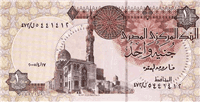 Obverse side of the 1 Egyptian pound is showing the Mosque of Sultan Qaitbay. |
 Reverse side of the 1 Egyptian pound is showing a part of the facade of Abu Simbel Temple. |
| 5 Egyptian Pounds | |
|---|---|
| Banknote of 5 Egyptian Pounds has dimensions 145×70 mm and main colors are slate gray, khaki, dark jungle green and grullo. The issue date of 5 Egyptian pounds banknote was 9 May 2002 and have a watermark with a mask of King Tutankhamoun. | |
 Obverse side of the 5 Egyptian Pounds is showing the Mosque of Ahmed Ibn Toulon |
 Reverse side of the 5 Egyptian Pounds is showing a relief pharaonic wall inscription. |
| 10 Egyptian Pounds | |
|---|---|
| Banknote of 10 Egyptian Pounds has dimensions 150×70 mm and main colors are thistle, languid lavender, wenge and pastel purple. The issue date of 10 Egyptian pounds banknote was 1 October 2003 and have a watermark with a shape of the Tutankhamoun mask. | |
 Obverse side of the 10 Egyptian Pounds is showing the Refa’ie Mosque in Cairo. |
 Reverse side of the 10 Egyptian Pounds is showing a statute of Chefren. |
| 20 Egyptian Pounds | |
|---|---|
| Banknote of 20 Egyptian Pounds has dimensions 155×70 mm and main colors are pale goldenrod, silver, dim gray and almond. The issue date of 20 Egyptian pounds banknote was 23 May 2001 and have a watermark with a mask of King Tutankhamoun. | |
 Obverse side of the 20 Egyptian Pounds is showing the Mosque of Mohammed Ali. |
 Reverse side of the 20 Egyptian Pounds is showing a gray wall tablet containing relief pharaonic drawings on one of the pillars of Sesostris I Temple |
| 50 Egyptian Pounds | |
|---|---|
| Banknote of 50 Egyptian Pounds has dimensions 160×70 mm and main colors are pale gold, bole, raw umber, cinereous and grullo. The issue date of 50 Egyptian pounds banknote was 29 November 2001 and have a watermark with the mask of King Tutankhamoun. | |
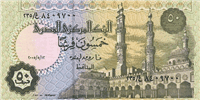 Obverse side of the 50 Egyptian Pounds is showing the Mosque of Abu Hariba. |
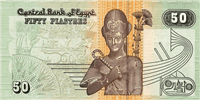 Reverse side of the 50 Egyptian Pounds is showing an inside view of Edfu Temple. |
| 100 Egyptian Pounds | |
|---|---|
| Banknote of 100 Egyptian Pounds has dimensions 165×70 mm and main colors are manatee, aurometalsaurus, cambridge blue and rose quartz. The issue date of 100 Egyptian pounds banknote was 13 November 2000 and have a watermark with the mask of King Tutankhamoun. | |
 Obverse side of the 100 Egyptian Pounds is showing the Mosque of Sultan Hassan. |
 Reverse side of the 100 Egyptian Pounds is showing the head of the Sphinx statue. |
| 200 Egyptian Pounds | |
|---|---|
| Banknote of 200 Egyptian Pounds has dimensions 175×80 mm and main colors are cordovan, dark chestnut, trolley grey and khaki. The issue date of 200 Egyptian pounds banknote was 1 August 2009 and have a watermark with the portrait of the Ancient Egyptian Scribe. | |
 Obverse side of the 200 Egyptian Pounds is showing the mosque of Qani-bai. |
 Reverse side of the 200 Egyptian Pounds is showing the seated scribe 5th dynasty. |
Useful links
- About Central Bank of Egypt:
- Central Bank of Egypt
- List of currencies:
- Currencies
- Security and design features of EGP banknotes:
- EGP banknotes
- EGP currency on Wikipedia:
- Egyptian pound
- Official Website of Central Bank of Egypt:
- www.cbe.org.eg
- Commemorative coins:
- Commemorative Coins